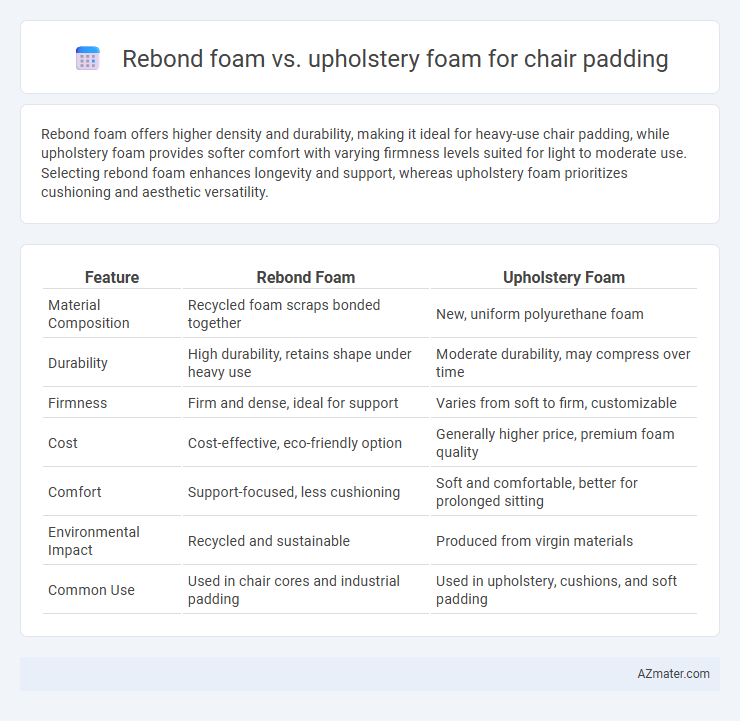Rebond foam offers higher density and durability, making it ideal for heavy-use chair padding, while upholstery foam provides softer comfort with varying firmness levels suited for light to moderate use. Selecting rebond foam enhances longevity and support, whereas upholstery foam prioritizes cushioning and aesthetic versatility.
Table of Comparison
| Feature | Rebond Foam | Upholstery Foam |
|---|---|---|
| Material Composition | Recycled foam scraps bonded together | New, uniform polyurethane foam |
| Durability | High durability, retains shape under heavy use | Moderate durability, may compress over time |
| Firmness | Firm and dense, ideal for support | Varies from soft to firm, customizable |
| Cost | Cost-effective, eco-friendly option | Generally higher price, premium foam quality |
| Comfort | Support-focused, less cushioning | Soft and comfortable, better for prolonged sitting |
| Environmental Impact | Recycled and sustainable | Produced from virgin materials |
| Common Use | Used in chair cores and industrial padding | Used in upholstery, cushions, and soft padding |
Introduction to Chair Padding Materials
Rebond foam offers high density and durability, making it ideal for heavy-use chair padding with excellent support and resilience. Upholstery foam typically features softer, lower-density material that provides plush comfort but may compress faster under regular use. Choosing between rebond foam and upholstery foam depends on the desired balance between firmness, longevity, and cushioning for chair seating applications.
What is Rebond Foam?
Rebond foam is a high-density cushioning material made from shredded and reprocessed foam scraps bonded together with adhesive, commonly used for chair padding due to its durability and firm support. Unlike traditional upholstery foam, rebond foam offers enhanced resilience and longevity, making it ideal for high-traffic seating applications where sustained comfort and shape retention are essential. Its dense composition provides superior weight distribution and resistance to compression over time compared to conventional polyurethane upholstery foam.
What is Upholstery Foam?
Upholstery foam is a high-resilience, flexible material specifically designed for chair padding to provide superior comfort and support. It is available in various densities and firmness levels, making it adaptable to different seating requirements and ensuring durability over time. Unlike rebond foam, upholstery foam offers a smoother, more consistent surface that enhances the overall aesthetic and ergonomic quality of upholstered chairs.
Key Differences: Rebond Foam vs Upholstery Foam
Rebond foam consists of shredded foam pieces bonded together, offering high density and firm support ideal for heavy-duty chair padding, while upholstery foam is typically more flexible with a softer, uniform texture designed for comfort and aesthetic appeal. Rebond foam provides superior durability and resilience, making it suitable for high-traffic seating, whereas upholstery foam prioritizes cushioning and softness for residential or decorative furniture. The key differences lie in their composition, density, and intended use, with rebond foam excelling in structural support and upholstery foam in user comfort.
Comfort Levels: Which Foam Feels Better?
Rebond foam offers a firm and supportive feel, making it ideal for chairs requiring enhanced durability and resilience over time. Upholstery foam provides a softer, more cushioned experience, promoting greater immediate comfort and contouring more closely to the body. For comfort levels, upholstery foam typically feels better for short-term sitting, while rebond foam excels in maintaining support during prolonged use.
Durability and Longevity Comparison
Rebond foam offers superior durability and longevity compared to upholstery foam due to its dense composition made from recycled foam scraps bonded together, providing enhanced resilience and structural integrity for chair padding. Upholstery foam, typically made from polyurethane, tends to compress and degrade faster under frequent use, leading to reduced support and comfort over time. Choosing rebond foam ensures a longer-lasting cushioning solution ideal for heavy-use chairs requiring sustained firmness and shape retention.
Support and Resilience for Sitting
Rebond foam offers superior support and high resilience, making it ideal for chair padding where durability and long-term firmness are essential. Upholstery foam provides a softer feel with moderate support, which can be comfortable but may compress faster under constant sitting pressure. Rebond foam's dense composition ensures better weight distribution and longer-lasting cushioning compared to traditional upholstery foam.
Cost and Value Analysis
Rebond foam offers higher durability and density, making it a cost-effective choice for long-term chair padding despite a higher initial price compared to upholstery foam. Upholstery foam is generally less expensive upfront but may compress faster, reducing comfort and requiring more frequent replacement, impacting overall value. Considering lifecycle cost and performance, rebond foam provides greater value for heavy-use chairs, while upholstery foam suits budget-conscious projects with lighter use.
Ideal Applications for Each Foam Type
Rebond foam is ideal for heavy-duty chair padding requiring high durability and firm support, such as office chairs and commercial seating, due to its density and resilience from recycled foam scraps bonded together. Upholstery foam is better suited for residential or decorative furniture where comfort and softness are prioritized, offering a smooth surface and consistent cushioning for sofas and lounge chairs. Selecting the appropriate foam ensures optimal comfort, longevity, and performance based on specific seating requirements.
Which Foam is Best for Your Chair?
Rebond foam offers superior durability and high density, making it ideal for heavy-use chairs requiring firm support and long-lasting comfort. Upholstery foam, typically softer and more flexible, provides enhanced cushioning and is better suited for decorative chairs or those used less frequently. Selecting the best foam depends on chair usage: rebond foam excels in commercial or high-traffic seating, while upholstery foam suits residential chairs prioritizing comfort and aesthetics.

Infographic: Rebond foam vs Upholstery foam for Chair padding
 azmater.com
azmater.com